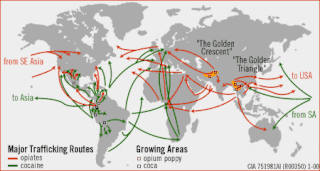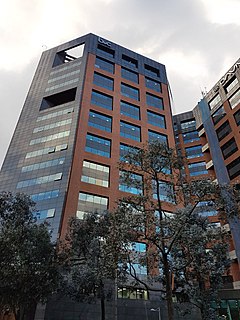
Latin America is the portion of the Americas comprising countries and regions where Romance languages—languages that derived from Latin—such as Spanish, Portuguese, and French are predominantly spoken. The term was originally used to refer to places in the Americas that were ruled under the Spanish, Portuguese, and French empires.

The illegal drug trade or drug trafficking is a global black market dedicated to the cultivation, manufacture, distribution and sale of prohibited drugs. Most jurisdictions prohibit trade, except under license, of many types of drugs through the use of drug prohibition laws. The think tank Global Financial Integrity's Transnational Crime and the Developing World report estimates the size of the global illicit drug market between US$426 and US$652 billion in 2014 alone. With a world GDP of US$78 trillion in the same year, the illegal drug trade may be estimated as nearly 1% of total global trade. Consumption of illegal drugs is widespread globally and it remains very difficult for local authorities to thwart its popularity.

The Pan-American Highway is a network of roads stretching across the Americas and measuring about 30,000 kilometres (19,000 mi) in total length. Except for a rainforest break of approximately 106 km (66 mi) across the border between southeast Panama and northwest Colombia, called the Darién Gap, the roads link almost all of the Pacific coastal countries of the Americas in a connected highway system. According to Guinness World Records, the Pan-American Highway is the world's longest "motorable road". However, because of the Darién Gap, there is no road linking South and Central America. It is only possible to cross by land between South America and Central America—the last town in Colombia to the first outpost in Panama—by a difficult and dangerous hike of at least four days through one of the rainiest areas of the planet.

Anyphaenidae is a family of araneomorph spiders, sometimes called anyphaenid sac spiders. They are distinguished from the sac spiders of the family Clubionidae and other spiders by having the abdominal spiracle placed one third to one half of the way anterior to the spinnerets toward the epigastric furrow on the underside of the abdomen. In most spiders the spiracle is just anterior to the spinnerets. Like clubionids, anyphaenids have eight eyes arranged in two rows, conical anterior spinnerets and are wandering predators that build silken retreats, or sacs, usually on plant terminals, between leaves, under bark or under rocks. There are more than 500 species in over 50 genera worldwide.

Panela or rapadura is an unrefined whole cane sugar, typical of Central and Latin America. It is a solid form of sucrose derived from the boiling and evaporation of sugarcane juice. Panela is known by other names in Latin America, such as chancaca in Chile, Bolivia and Peru, piloncillo in Mexico. The name piloncillo means little loaf, because of the traditional shape in which this smoky, caramelly and earthy sugar is produced. Just like brown sugar, there are two varieties of piloncillo; one is lighter (blanco) and one darker (oscuro). Unrefined, it is commonly used in Mexico, where it has been around for at least 500 years. Made from crushed sugar cane, the juice is collected, boiled and poured into molds, where it hardens into blocks. Panela is also known as rapadura in Portuguese. Elsewhere in the world, the word jaggery describes a similar foodstuff. Both of them are considered non-centrifugal cane sugars.

Zúñiga is a town and municipality located in the province and autonomous community of Navarre, northern Spain.
The Americas Region Caribbean Ring System (ARCOS-1) is a fiber optic submarine communications cable of 8,400 kilometers that extends between the United States, the Bahamas, the Turks and Caicos Islands, the Dominican Republic, Puerto Rico, Curaçao, Venezuela, Colombia, Panama, Costa Rica, Nicaragua, Honduras, Guatemala, Belize, and Mexico. Because of its length, it was divided in two phases: Phase 1 being in service since September 2001 and Phase II since March 2002. The cable system was set in a ring configuration and is operated on a non-common carrier basis.

Mayaca is a genus of flowering plants, often placed in its own family, the Mayacaceae. In the APG II system of 2003, it is assigned to the order Poales in the clade commelinids. The Cronquist system, of 1981, also recognised such a family and placed it in the order Commelinales in the subclass Commelinidae.

Scooby-Doo! and the Monster of Mexico is a 2003 American direct-to-video animated comedy mystery film; the sixth in a series of direct-to-video films based upon the Scooby-Doo Saturday morning cartoons. It was released on September 30, 2003, and it was produced by Warner Bros. Animation.

The Colombia Securities Exchange is a stock exchange which was created as a result of merging three independent stock exchanges: Bogotá, Medellín and Occidente. It has offices in Bogotá, Medellín and Cali. Furthermore, with the bvc Training Centers the company is located in 19 Colombian cities through agreements with universities and chambers of commerce.

Miss International 2001, the 41st Miss International pageant, was held on October 4, 2001 at the Nakano Sun Plaza in Tokyo, Japan. At the end of the event, Vivian Urdaneta of Venezuela crowned her successor Małgorzata Rożniecka of Poland.

The Sinaloa Cartel, also known as the CDS, the Guzmán-Loera Organization, the Pacific Cartel, the Federation and the Blood Alliance, is a large international drug trafficking, money laundering, and organized crime syndicate established in Mexico during the late 1980s as one of a various number of "plazas" operating under a predecessor organization known as the Guadalajara Cartel. It is currently headed by Ismael Zambada García and is based in the city of Culiacán, Sinaloa, with operations in many world regions but primarily in the Mexican states of Sinaloa, Baja California, Durango, Sonora, and Chihuahua. It also has a notable presence in a number of other regions in Latin America, such as Colombia; as well as in cities across the U.S. The United States Intelligence Community generally considers the Sinaloa Cartel to be the most powerful drug trafficking organization in the Western Hemisphere, making it perhaps even more influential and capable than the infamous Medellín Cartel of Colombia was during its prime. It has repeatedly been said to be one of the strongest criminal organizations in the world and indisputably the most powerful in Mexico since at least the late 2000s and early 2010s by various sources including the Los Angeles Times.

Midila is a genus of moths of the family Crambidae.

Mexican visas are documents issued by the National Migration Institute, dependent on the Secretariat of the Interior, with the stated goal of regulating and facilitating migratory flows.
Midila carneia is a moth in the family Crambidae. It was described by Druce in 1902. It is found in Colombia.
Midila leonila is a moth in the family Crambidae. It was described by M. G. Lopez-Torres in 1985. It is found in Hidalgo, Mexico.

Midila quadrifenestrata is a moth in the family Crambidae. It was described by Gottlieb August Wilhelm Herrich-Schäffer in 1858. It is found in Brazil, Bolivia and French Guiana.
Midila rommeli is a moth in the family Crambidae. It was described by M. G. Lopez-Torres in 1985. It is found in Oaxaca, Mexico.












